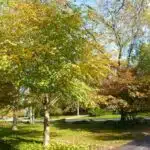The White Fir, or Abies concolor, is a popular and beautiful evergreen tree that is native to the western United States. Known for its striking silvery-blue needles and tall, straight growth habit, the White Fir makes an excellent addition to any landscape. As a horticultural writer, I have researched and compiled this guide on how to grow and care for the White Fir in order to provide readers with the knowledge they need to successfully cultivate this stunning tree.
The White Fir is a relatively low-maintenance tree that can thrive in a variety of conditions, making it an ideal choice for homeowners who want a beautiful and sustainable addition to their yard or garden. However, like all plants, the White Fir requires specific care in order to reach its full potential. In this article, we will discuss everything from planting and watering techniques to pruning and disease prevention strategies. Whether you are an experienced gardener or just starting out, this guide will provide you with the information you need to grow and care for your White Fir tree with confidence.
Understanding The White Fir Tree
The white fir tree, scientifically known as Abies concolor, is a species of evergreen conifer native to North America. It is a medium-sized tree that can reach up to 100 feet in height and 40 feet in width. The white fir has a narrow and conical shape with dense foliage consisting of long needles that can be blue-green or silvery-white in color.
The white fir tree has various uses in the landscape industry. Its elegant shape and beautiful foliage make it an ideal choice for ornamental purposes such as hedges, screens, and windbreaks. Additionally, the wood of the white fir is used for construction purposes such as framing, decking, and flooring. It is also used for making paper pulp and Christmas trees.
The importance of the white fir tree in landscaping cannot be overstated. Its aesthetic value adds beauty to both urban and rural landscapes while providing numerous environmental benefits such as air purification, soil stabilization, and erosion control. Furthermore, the white fir provides shelter to wildlife such as birds, squirrels, and deer who depend on it for food during winter months when other food sources are scarce. As such, understanding how to grow and care for this magnificent tree is essential for any landscaper or homeowner looking to add value to their property through landscaping.
When considering planting a white fir tree, choosing the right location is crucial for its survival and growth.
Choosing The Right Location For Your White Fir
When selecting a location to grow your white fir tree, it is essential to consider several factors. First and foremost, ensure that the chosen location has adequate sun exposure. White firs require full sun exposure to thrive and grow properly. Therefore, choose an area where your tree can receive at least six hours of direct sunlight each day.
Apart from sun exposure, soil quality is another critical factor to consider when choosing a location for your white fir tree. The ideal soil for this species should be well-draining with a pH level ranging between 6.0-7.5. If the soil in your area is not suitable for planting, you can improve it by adding organic matter such as compost or peat moss.
In some urban settings, protection methods may be necessary to ensure the successful growth of your white fir tree. For instance, if you live in an area prone to strong winds or heavy snowfall, you may need to provide support for your tree or use anti-desiccant sprays during winter months. Additionally, avoid planting your white fir near roadsides or areas with high pollution levels as this can affect its growth rate and overall health.
Now that you have selected the right location for your white fir tree let’s move on to planting it in the next section. Ensure that all conditions are met before proceeding with planting to guarantee optimal growth and maintenance of your white fir tree over time.
Planting Your White Fir Tree
Before planting your white fir tree, it is crucial to prepare the soil. The ideal location for planting a white fir tree is in well-draining soil that is slightly acidic. A soil test can help you determine the pH of your soil and if any amendments are necessary. If the soil is too alkaline, you may need to add sulfur or peat moss to lower the pH level. If the soil is heavy clay, adding compost or sand can improve drainage.
Once the soil has been prepared, dig a hole that is twice as wide as the root ball but not deeper than its height. Gently remove the tree from its container and loosen any tangled roots before placing it in the hole. Backfill with soil, tamping it down gently around the base of the tree. Finally, mulch around the tree with 2-3 inches of organic material such as bark chips or shredded leaves to retain moisture and suppress weeds.
Proper mulching techniques play a critical role in ensuring your white fir tree’s health and longevity. Avoid piling mulch up against the trunk of your tree as this can lead to rot and disease. Instead, create a donut-shaped ring around your tree’s base with a small gap between the mulch and trunk to encourage air circulation. Mulch should be refreshed annually in early spring after winter weather has subsided.
Now that you have successfully planted your white fir tree, it’s time to move on to watering techniques to ensure optimal growth and health for years to come.
Watering Your White Fir Tree
Watering frequency is an essential aspect of caring for your white fir tree. It is necessary to ensure that the soil remains moist but not waterlogged. The frequency of watering will depend on the weather, humidity, and soil type. During hot and dry weather, the tree will need more frequent watering compared to cooler seasons.
Overwatering can be detrimental to the health of your white fir tree. Signs of overwatering include yellowing needles, root rot, and mold growth in the soil. To avoid overwatering, it is crucial to monitor the moisture level in the soil regularly. A simple technique is to insert a finger into the soil up to two inches deep; if it feels dry, then it’s time to water.
Watering techniques play a significant role in ensuring your white fir tree receives adequate moisture while avoiding overwatering. Using a soaker hose is an efficient technique as it delivers water directly to the roots without wasting any water through evaporation or runoff. It also helps maintain even moisture levels throughout the soil profile.
Transition: Adequate watering is crucial for maintaining a healthy white fir tree. However, fertilizing also plays an important role in providing essential nutrients for its growth and development. In the next section, we will discuss appropriate fertilization techniques for your white fir tree.
Fertilizing Your White Fir Tree
For healthy growth and development, fertilizing your white fir tree is essential. Using organic fertilizers is an excellent way to provide the necessary nutrients without harming the environment. Organic fertilizers are derived from plant and animal matter and break down slowly, releasing their nutrients over time. This slow release allows your white fir tree to absorb the nutrients gradually, promoting steady growth and development.
The best time to fertilize your white fir tree is in early spring before new growth begins. Applying fertilizer during this time ensures that the tree has access to the necessary nutrients when it needs them most. It’s important not to over-fertilize your white fir tree as excess fertilizer can lead to root burn, which can severely damage or even kill the tree. Always follow the instructions on the fertilizer packaging carefully.
To ensure optimal growth and development of your white fir tree, here are five tips for fertilizing:
- Use organic fertilizers for better nutrient absorption.
- Apply fertilizer in early spring when new growth begins.
- Avoid over-fertilizing as it can harm your white fir tree.
- Always follow instructions on fertilizer packaging carefully.
- Water your tree after applying fertilizer to help with nutrient absorption.
With these tips in mind, you’ll be able to provide your white fir tree with the necessary nutrients for healthy growth and development. In the next section, we will discuss how pruning can enhance the aesthetic appeal of your white fir tree while also promoting healthy growth.
Pruning Your White Fir Tree
- Pruning of white fir trees should take place at the end of winter or early spring in order to effectively shape the tree and encourage healthy new growth.
- Pruning tools such as secateurs, loppers, saws and shears should be used to ensure the branches are cut cleanly, avoiding any damage to the tree.
- To maintain a healthy tree structure, pruning should focus on removing dead, diseased or damaged branches, as well as any branches that are growing in a way that could cause damage to other parts of the tree.
- To promote a natural shape and encourage the growth of new shoots, pruning should be done in a selective manner, removing only the parts of the tree which are necessary.
- To avoid ripening damage, pruning of white fir trees should be done in a way that encourages air circulation and light penetration, as well as avoiding heavy pruning to one side of the tree.
- Finally, when pruning a white fir tree, it is important to make sure that the branches are cut back to a node or branch collar to allow for healthy regrowth.
When To Prune
Imagine walking out into your backyard and seeing a beautiful, healthy white fir tree. To keep it looking its best, it is essential to know when and how to prune the tree properly. The best time to prune your white fir is during the dormant season, which typically occurs from late fall to early spring. During this time, the tree is not actively growing, making it easier for you to see the structure of the tree and identify any problem areas.
Before you begin pruning your white fir, you will need some essential tools. These include a sharp pair of pruning shears for smaller branches and a pruning saw for larger ones. To prevent the spread of disease or infection between trees, make sure that all tools are clean and sanitized before use. When pruning your white fir, focus on removing any dead or diseased branches first, followed by any crossing or rubbing branches. Be sure to also remove any branches that interfere with walkways or structures.
So how often should you prune your white fir? As a general rule of thumb, it is best to avoid excessive pruning as this can harm the tree’s overall health and structure. Instead, consider pruning every two to three years as needed to maintain the tree’s shape and remove any damaged or diseased branches. By following these simple techniques for pruning your white fir tree with the best tools available, you can ensure that it remains healthy, vibrant and beautiful for many years to come!
Pruning Tools
Pruning your white fir tree is a crucial aspect of maintaining its health and beauty. To achieve this, it is essential to have the right tools for the job. Pruning tools come in different shapes and sizes, and each tool serves a specific purpose. The right tools will make pruning easier, quicker, and safer.
When choosing pruning tools for your white fir tree, it’s important to consider their quality. Quality pruning tools are made of durable materials that can handle repeated use without breaking or becoming dull quickly. Using sharp and high-quality pruning shears or saws makes it easier to make clean cuts that heal quickly, reducing the risk of infection or disease.
Safety precautions are also vital when using pruning tools on your white fir tree. Wearing safety gloves and goggles can help protect you from injuries while working with sharp blades or thorny branches. Additionally, always ensure that your equipment is well-maintained before use by checking for any damages or defects that could cause harm during operation. By following proper pruning techniques and safety precautions when using the right tools, you can maintain the health and beauty of your white fir tree effectively.
Pruning Techniques
Pruning is an essential task to keep your white fir tree healthy and attractive. It involves removing dead, diseased, or damaged branches to promote new growth and maintain the tree’s shape. Pruning frequency depends on the age and size of your tree, as well as your pruning goals. Young trees require more frequent pruning than mature ones, while over-pruning can weaken the tree’s structure and reduce its energy reserves.
To achieve the best results when pruning your white fir tree, it’s essential to use the right tools and techniques. Pruning tools come in different shapes and sizes, from pruning shears to chainsaws. The choice of tool depends on the size of the branch you want to remove and its location on the tree. For instance, hand pruners are ideal for small branches close to the trunk, while pole saws are useful for higher branches.
When it comes to pruning techniques, it’s crucial to follow some basic rules to avoid damaging your white fir tree. Firstly, make sure you only prune during the dormant season (late fall or winter) when there is no active growth. Secondly, always cut at a slight angle just outside the branch collar (the swollen area where a branch joins another branch or trunk). This technique helps wounds heal faster and prevents decay from entering into healthy wood. Lastly, avoid leaving stubs or flush cuts as they can cause dieback or disease entry. By following these basic principles of pruning techniques with high-quality tools that suit your needs will help maintain your white fir tree’s health for many years to come!
Common Pests And Diseases Of The White Fir Tree
After pruning your white fir tree, it’s essential to keep an eye out for any pests or diseases that may harm your tree’s health. One common pest that affects white firs is aphids, which are tiny insects that feed on the sap of the needles. These pests can cause stunted growth and yellowing of the needles. To control aphids, you can spray the infested areas with an insecticidal soap or oil.
Fungal infections in white firs can also be a significant problem, especially in humid climates. Symptoms of fungal infections include brown or black spots on the needles, needle loss, and twig dieback. To prevent these infections, ensure proper air circulation around your tree by spacing them appropriately when planting. If you notice any signs of fungal infection, prune affected branches immediately and dispose of them properly.
Identifying spider mites can be tricky since these pests are microscopic; however, signs of their presence include yellow stippling on the needles and fine webbing between branches. To control spider mites effectively, use a miticide spray or increase humidity levels around your tree by misting its foliage regularly. Preventing needle cast disease involves keeping your tree healthy by avoiding overwatering and providing adequate drainage for its roots.
Preventing and treating white fir tree diseases is crucial to ensure its continued growth and overall health. By taking preventative measures such as proper spacing during planting and regular misting to increase humidity levels around your tree, you’ll significantly reduce the risk of fungal infections and spider mite infestations. In case you notice any sign of disease or pest presence such as aphids or spider mites, prompt action such as pruning affected branches or using miticide sprays will prevent further damage to your white fir tree’s health.
Preventing And Treating White Fir Tree Diseases
White fir trees are a popular choice for landscaping due to their striking blue-green color and ability to grow in a variety of climates. However, these trees may be prone to disease. It is important to be able to identify any potential diseases so that appropriate preventive measures can be taken. Symptoms of white fir tree diseases may include yellowing needles, discolored needles, and stunted growth. Early diagnosis is key to preventing infection from spreading. Preventive measures include improving the soil nutrition and drainage, and avoiding any damage to the trunk or roots. Furthermore, it is important to avoid overcrowding, as this can increase the risk of disease. Treatment for infected trees may involve pruning, removing infected branches, or applying a fungicide.
Identifying Diseases
Identifying diseases in white fir trees is crucial for their proper growth and overall health. Common symptoms of white fir diseases include yellowing or browning needles, premature needle drop, stunted growth, and twig dieback. These symptoms can be caused by various factors such as fungal or bacterial infections, insect infestations, nutrient deficiencies, or environmental stressors.
Treatment options for white fir diseases depend on the specific disease and its severity. Fungal infections can be treated with fungicides, while bacterial infections may require pruning of infected branches to prevent further spread. Insect infestations can be controlled using insecticides or natural predators such as ladybugs or praying mantises. Nutrient deficiencies can often be addressed through fertilization and soil amendments.
Preventative measures and natural remedies are also important for maintaining white fir tree health. Regular watering, proper pruning techniques, and adequate fertilization can help prevent many diseases from occurring. Natural remedies such as neem oil or garlic spray can also be used to control pests without the use of harmful chemicals. Overall, identifying diseases early on and taking appropriate preventative measures and treatment options are essential for maintaining the health of your white fir trees.
Preventing Infection
Preventing infection in white fir trees is crucial for maintaining their overall health and preventing the spread of diseases. Identifying symptoms early on is key to implementing preventative measures before a disease takes hold. Regularly inspecting the tree for yellowing or browning needles, premature needle drop, stunted growth, or twig dieback can help catch any potential issues before they become severe.
Proper pruning techniques can also help prevent infection from spreading throughout the tree. Removing infected branches can prevent further spread of fungal or bacterial infections. Additionally, avoiding damage to the bark and roots during maintenance tasks such as mowing or trimming can help prevent entry points for pests and diseases.
Another important preventative measure is proper fertilization and soil management. Ensuring the tree has access to adequate nutrients can help it resist disease and promote healthy growth. Soil amendments such as compost or mulch can also help retain moisture and improve soil structure, which in turn supports healthier root development. By taking these preventative measures, white fir trees are better equipped to resist disease and maintain their aesthetic appeal in a landscape setting.
Treating Infection
When it comes to maintaining the health of white fir trees, preventing diseases is key. However, despite preventive measures, disease can still occur. Treating infections early on is crucial to preventing further spread and ensuring the tree’s survival.
One way to treat infection is through the use of fungicides or bactericides. These products can help eliminate harmful pathogens that may be causing disease in the tree. It’s important to note that not all diseases can be treated with these chemicals, so proper diagnosis is necessary before treatment.
Pruning infected branches and improving soil conditions can also aid in treating infections. Removing damaged or diseased branches can prevent further spread of disease throughout the tree while promoting healthy growth. Improving soil conditions with proper amendments and fertilization can help boost the tree’s immune system, making it more resistant to disease. By combining these approaches with preventative measures such as regular inspections and maintenance tasks, white fir trees can thrive in a landscape setting.
Winter Care For Your White Fir Tree
During the winter, white fir trees require a bit of extra care to ensure their survival and health. One important aspect of winter care for these trees is protecting their branches from heavy snow loads. Snow can accumulate on the branches and cause them to break, which can severely damage or even kill the tree. To protect your white fir tree’s branches, use a broom or other tool to gently brush off any snow that accumulates on them.
Another key aspect of winter care for white fir trees is mulching the soil around their base. Mulch helps to insulate the roots from extreme temperatures and prevents moisture loss from the soil. Apply a layer of 3-4 inches of organic mulch, such as wood chips or shredded leaves, around the base of your tree. Be sure to keep the mulch at least 2-3 inches away from the trunk to prevent rot.
In addition to protecting branches and mulching soil, it is important to monitor your white fir tree for any signs of stress during the winter months. Look out for wilting or yellowing leaves, which could indicate that the tree is not getting enough water or nutrients. If you notice any issues with your tree’s health, consult with a professional arborist who can provide guidance on how best to care for your specific tree.
With proper winter care, your white fir tree will be better equipped to withstand harsh weather conditions and thrive in the years ahead. By taking steps like protecting its branches and mulching its soil, you can help ensure that your tree remains healthy and strong for many winters to come. In the next section, we will explore how you can enjoy all of the beauty and benefits that your white fir tree has to offer throughout the rest of the year.
Enjoying The Beauty And Benefits Of Your White Fir Tree
Winter might be a challenging time for your white fir tree, but with proper care, it will thrive and reward you with its beauty and benefits all year round. However, as the temperature starts to rise, it is time to shift your focus towards enjoying the tree’s full potential. Have you thought about how you would like to decorate your white fir this season?
The white fir is an excellent choice for Christmas trees due to its symmetrical shape and needle retention. Its soft needles are perfect for hanging ornaments, tinsel, and lights. Additionally, its branches can support heavier decorations without bending or breaking. Consider using LED lights that are energy-efficient and safe for the environment. You can also add a personal touch by making homemade decorations such as popcorn garlands or paper snowflakes.
Apart from being a beautiful addition to your landscape, the white fir tree offers numerous benefits to wildlife. It provides shelter for birds, squirrels, and other small animals during harsh weather conditions. The dense foliage of the tree also serves as a nesting site during breeding seasons. Additionally, the seeds of the white fir are a source of food for various wildlife species such as deer and rodents.
Incorporating these decorating ideas while considering wildlife benefits will enhance your experience with the white fir tree. Enjoying its beauty while knowing that it is contributing positively to nature brings a sense of fulfillment that transcends personal enjoyment alone. A well-cared-for white fir tree will continue providing these benefits and more for many years to come.
Conclusion
The White Fir Tree is a popular choice for landscaping due to its unique beauty and versatility. Understanding the proper care and maintenance of this tree is essential to ensuring its longevity and continued growth. Choosing the right location, planting correctly, watering appropriately, fertilizing regularly, and preventing diseases are all vital steps in caring for your White Fir Tree.
Preventing pests, such as spider mites or aphids, and treating any diseases that may arise will help keep your tree healthy year-round. It is also important to take care of your White Fir Tree during the winter months by protecting it from harsh weather conditions. By following these guidelines and giving your White Fir Tree the care it deserves, you can enjoy its beauty and benefits for many years to come.
Image Credits
- “1948. Western spruce budworm defoliation of Douglas-fir and white fir. Tupper area. Umatilla National Forest, Oregon.” by USDA Forest Service (featured)





























